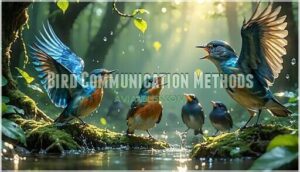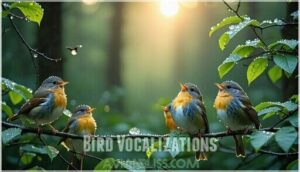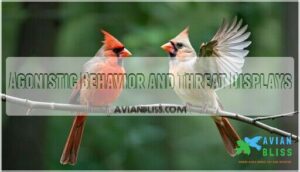This site is supported by our readers. We may earn a commission, at no cost to you, if you purchase through links.
 You’ll find that birds communicate through four main methods: vocalizations, visual displays, touch, and chemical signals.
You’ll find that birds communicate through four main methods: vocalizations, visual displays, touch, and chemical signals.
Their songs and calls serve different purposes—from attracting mates to warning of predators.
Watch closely and you’ll notice intricate body language too; a blue jay’s raised crest isn’t just for show but signals alertness or aggression.
Some birds, like petrels, even use scent marking, though it’s less common than their vocal talents.
When you see a cardinal singing at dawn, he’s not just being musical—he’s establishing territory and letting potential mates know he’s available.
The complexity behind these seemingly simple behaviors reveals nature’s ingenious design.
Table Of Contents
- Key Takeaways
- Bird Communication Methods
- Bird Vocalizations
- Visual Communication
- Bird Social Interactions
- Bird Survival Strategies
- Frequently Asked Questions (FAQs)
- What are the communication strategies of birds?
- What are the four birds’ communication styles?
- Which is the method used by most birds to communicate?
- Which form of communication does a bird use?
- What is Bird communication?
- How do you communicate with birds?
- What are bird behavior and communication patterns?
- How do nocturnal birds communicate?
- What is vocal communication in birds?
- Why do birds use combinatorial signals?
- Conclusion
Key Takeaways
- You’ll see birds communicate through vocalizations, visual displays, chemical signals, and touch to share essential messages about territory, danger, and mating.
- Songs and calls are their main tools for attracting mates, marking territory, and warning of predators, with some even mimicking other species.
- Birds use body language like puffing feathers, bobbing heads, and vibrant plumage to signal emotions and dominance during courtship or territorial disputes.
- Chemical signals, like scent markers, are subtle but vital for species recognition, mate attraction, and predator avoidance, showcasing birds’ survival strategies.
Bird Communication Methods
You’d be amazed by how many clever ways birds communicate with each other to survive, thrive, and keep their world in balance.
From melodic songs to bold visual displays and even chemical cues, their methods are as fascinating as they’re essential, including the use of chemical cues.
Vocalizations and Songs
Bird vocalizations are like nature’s symphony, with bird songs showcasing complexity and charm.
Songbird communication thrives on regional dialects, mimicry abilities, and vocal learning, creating a fascinating world of avian vocalization.
Acoustic adaptation helps birds adjust songs for their environments, while bird song analysis reveals meaningful patterns.
Understanding avian sound recognition can greatly improve birding experiences.
These intricate tunes aren’t just music—they’re the language of survival and connection.
Body Language and Visual Displays
You’ve heard their songs, but birds also "speak" with their bodies. Watch for plumage signaling, like bright feathers flaunted during breeding, or posture meanings, such as puffed chests showing dominance.
Curious about avian expressions? Understanding avian communication cues can deepen your appreciation of these animals.
- Gesture variations, like wing shaking, convey moods.
- Body language includes head bobbing to display confidence.
- Display evolution highlights courtship moves with flair!
Chemical Communication and Scent Marking
While feathers and postures steal the show, bird communication also relies on scents.
The uropygial gland produces oils for species recognition and mate attraction, a subtle form of pheromone signaling.
Petrels and auks use chemical defenses to ward off predators.
Though avian olfaction often goes unnoticed, it’s like nature’s silent messenger, keeping bird behavior linked with survival and connection.
Bird Vocalizations
You’ll notice that birds are expert vocalists, using a stunning range of sounds to communicate everything from warnings to romantic intentions.
By understanding their songs and calls, you can decipher the secret messages hidden in the symphony of the natural world.
Calls Vs. Songs
Songs and calls are the yin and yang of bird communication.
Songs, with their melodic complexity, attract mates and claim territory, while calls serve practical functions—warning of danger or signaling location.
Dialect variation in bird songs adds regional charm, and mimicry influence spices it further, showcasing acoustic adaptation.
Mastering these vocal tools reflects birds’ intricate behavior and vocal learning prowess.
Variability in Vocalizations
Not all bird vocalizations sound alike—regional dialects, mimicry abilities, and individual signatures make them unique.
Some birds adapt vocalizations to noisy environments, like tweaking song complexity in urban areas.
Certain species even imitate others, expanding their communication signals, which is a key aspect of bird dialect development and highlights the creativity in bird vocal learning, and this ability to adapt helps guarantee efficient communication.
Learning and Development of Songs
Young birds perfect their songs through imitation learning, mimicking adult vocalizations during a critical period.
Neural mechanisms in their brains fine-tune melodies, leading to song acquisition. Like accents in humans, bird dialects form regionally, creating unique tunes.
Bird vocal learning involves practice and adaptation, shaping complex songs over time. These variations can be influenced by environmental and social factors.
Their development demonstrates remarkable parallels to how we learn language—truly fascinating! It highlights the complex songs that birds are capable of producing.
Visual Communication
You’ll often see birds use visual signals like colorful feathers, puffed chests, or sharp wing movements to communicate.
These displays aren’t just for show—they convey important messages about territory, mates, and even warning signs to rivals, which can be considered as warning signs.
Agonistic Behavior and Threat Displays
During confrontations, you’ll witness fascinating dominance displays as birds communicate aggression through strategic posture signaling.
When defending territory, they’ll manipulate their feathers to appear larger, snap their beaks menacingly, and use wing threats to intimidate rivals.
These bird warning signals aren’t random—they’re sophisticated defensive behaviors designed to establish hierarchy without physical combat.
Next time you spot a cardinal puffing its chest or a blue jay’s crest rising, you’re seeing bird territoriality in action, which involves complex strategic posture signaling.
Courtship Displays and Mating Rituals
While threat displays showcase aggression, courtship rituals reveal a softer side of avian communication.
You’ll notice stunning plumage signals when male peacocks fan their magnificent tails to attract females.
Bird courtship often involves ritualized dances, with pairs performing synchronized movements that strengthen pair bonding.
Some species even practice gift giving, offering food or nest materials to potential mates.
In lek behavior, males gather in special areas to show off their best bird mating signals.
American Kestrels, for example, use aerial maneuvers and vocalizations to attract a mate.
Territorial Displays and Resource Competition
When birds stake out territories, they’re not just protecting a patch of real estate—they’re securing essential resources.
You’ll notice different display intensities as birds establish dominance hierarchies through visual signals.
Resource guarding becomes apparent when birds puff up feathers or spread wings to appear larger, and competition strategies vary by species, with territory size often reflecting resource availability.
This avian behavior helps birds defend food sources, nesting sites, and potential mates through strategic territorial defense, which is crucial for their survival, and by doing so, they’re able to protect their essential resources.
Bird Social Interactions
You’ll witness a fascinating array of social behaviors when birds interact, from cooperative food sharing to complex territorial disputes that establish their social hierarchies.
These interactions aren’t just random encounters but carefully orchestrated communications that help birds survive, find mates, and maintain their place in the avian community.
Foraging and Food Sharing
While visual displays communicate intent, food-finding creates another dimension of bird interaction.
You’ll notice birds often forage in groups, using food calls to alert others about discoveries.
This cooperative behavior strengthens social bonds while offering safety in numbers.
- A raven pair taking turns guarding their cache while the other feeds
- Colorful parent birds stuffing impossibly large insects into tiny chick mouths
- Crows dropping nuts on roadways, waiting for cars to crack them open
- Woodpeckers storing acorns in specially created holes for later retrieval
When watching birds feed, you’re witnessing complex communication systems at work.
Dominant individuals typically access resources first, while subordinates wait their turn.
This scavenging behavior follows strict social rules, with chick feeding priorities shifting as offspring mature.
Territorial Defense and Social Hierarchy
A bird’s territorial defense mechanisms reveal fascinating aspects of avian social behavior.
When you observe birds in the wild, you’ll notice their complex hierarchies and boundary disputes.
| Behavior Type | Description | Purpose | Example Species |
|---|---|---|---|
| Dominance Displays | Puffed feathers, raised wings | Establish pecking orders | Jays, Cardinals |
| Resource Guarding | Aggressive chasing, bird aggression | Protect food sources | Sparrows, Finches |
| Bird Territorial Songs | Loud, repetitive calls | Mark boundaries | Robins, Wrens |
| Cooperative Defense | Group mobbing of predators | Collective protection | Crows, Blackbirds |
Long-Distance Communication and Migration Calls
During long migratory journeys, birds communicate through specialized migration call types that carry across vast distances.
You’ll notice these bird sounds change with atmospheric effects like humidity and wind. Species recognition happens through unique acoustic communication patterns, despite environmental noise.
Birds carefully balance energetic costs when vocalizing while flying. Next time you hear overhead chirps at night, you’re witnessing an ancient, carefully evolved language that guides flocks safely to their destinations.
These vocalizations are essential for maintaining social bonds and play a crucial role in the overall migration process, highlighting the importance of social interactions.
Bird Survival Strategies
You’ll discover how birds use complex communication systems to outsmart predators and find suitable mates, ensuring their species’ survival against seemingly impossible odds.
From elaborate warning calls that specify threat types to intricate courtship displays that showcase genetic fitness, these feathered strategists have mastered the art of staying alive in a world full of challenges, using complex communication systems and elaborate warning calls.
Avoiding Predators and Chemical Cues
When danger lurks nearby, you’ll notice birds employ sophisticated chemical cues to assess predation risks.
They can detect scent markers from predators and even killed conspecifics, allowing them to adjust their defense strategies accordingly.
Blue tits won’t roost in nest-boxes containing predator scent, demonstrating their remarkable scent-based evasion skills.
Plumage provides camouflage to further reduce a bird’s visibility.
This chemical defense system works alongside predator alarm calls to create a thorough survival network, helping birds avoid becoming someone else’s dinner.
Mate Selection and Recognition
Beyond detecting predator signals, you’ll find that mate selection in birds involves fascinating communication.
Females choose partners showing bright plumage signals and complex songs that indicate good health and survival ability.
When listening to bird mating calls, you’re witnessing courtship rituals where males display sometimes impractical but attractive features – like a peacock’s magnificent tail.
You can find specialized audio products to help identify different species.
After pairing, males often engage in mate fidelity behaviors including guarding to guarantee their genetic compatibility passes to offspring.
Bird Recognition and Mate Selection
While mate selection hinges on visual cues, recognition goes deeper.
You’ll notice birds identify each other through distinctive songs that serve as acoustic fingerprints. Females typically prefer mates with larger song complexity, which explains why male birds evolve increasingly elaborate tunes.
Their plumage signals genetic compatibility, with some species even detecting ultraviolet reflections invisible to us.
These courtship rituals aren’t just beautiful displays—they’re sophisticated communication systems ensuring ideal reproductive success through bird attraction and showcasing elaborate tunes.
Frequently Asked Questions (FAQs)
What are the communication strategies of birds?
Vibrant voices and visual vues! You’ll find birds use calls, songs, and vibrant displays to communicate.
They’ll employ plumage presentations, posturing, and even chemical signals to share information about territory, mating availability, and potential dangers, utilizing vibrant displays to convey their messages.
What are the four birds’ communication styles?
Birds communicate through four distinct styles: vocal sounds (songs and calls), visual displays (plumage and postures), chemical signals (scents), and tactile communication (touching and preening).
You’ll notice these methods working together in your backyard observations, utilizing complete concepts to create a comprehensive understanding.
Which is the method used by most birds to communicate?
Like troubadours of the air, vocal communication reigns supreme among our feathered friends.
You’ll hear them use songs and calls to attract mates, defend territories, warn of danger, and maintain contact.
Which form of communication does a bird use?
You’ll notice birds use four main communication methods: vocal (songs and calls), visual (displays and plumage), chemical signals, and tactile interactions like allopreening.
Their communication style depends on the message they’re trying to convey, utilizing these methods to effectively express themselves through chemical signals.
What is Bird communication?
The symphony of feathers unfolds as you observe avian communication.
You’ll notice birds use vocalizations (songs and calls), visual displays, body language, and even chemical signals to share information about territory, mates, food, and dangers.
The information shared includes details about territory, mates, food, and dangers.
How do you communicate with birds?
You can communicate with birds by mimicking their calls, moving slowly, offering food, maintaining consistent routines, and watching their body language.
They’ll recognize you’re not a threat when you’re predictable and calm.
What are bird behavior and communication patterns?
Birds communicate through songs, calls, and visual displays like wing flapping and head bobbing.
You’ll notice distinct patterns during mating season when they’re establishing territories and attracting mates with complex vocalizations, which include a variety of sounds and visual displays.
How do nocturnal birds communicate?
Over 90% of nocturnal bird species rely primarily on vocal communication. You’ll hear their distinctive hoots, whistles, and calls after sunset when visual signals become less effective in the darkness.
What is vocal communication in birds?
You’ll hear birds using vocal communication through songs and calls.
They’re producing sounds with their syrinx (voice box) to attract mates, defend territory, signal danger, or stay connected with their flock.
Why do birds use combinatorial signals?
Ever wonder why birds mix sounds, gestures, and colors?
It’s like creating unique codes to guarantee their message sticks.
By combining signals, they boost clarity, adapt to situations, attract mates, or warn of predators efficiently, using complete concepts and unique codes to convey their messages.
Conclusion
Much like deciphering the mysteries of Morse code, understanding bird behavior communication methods reveals a fascinating world of vocalizations, visual cues, touch, and even subtle chemical messages.
These signals help birds navigate challenges like finding mates, avoiding predators, and defending territories.
Next time you see a cardinal’s bold song or a jay’s crest raised in warning, you’ll appreciate nature’s brilliant ingenuity.
By observing these behaviors closely, you’re glimpsing the complexity woven into their survival strategies.
- https://doi.org/10.1016/j.conb.2016.01.005
- https://pubmed.ncbi.nlm.nih.gov/16701358/
- https://www.fs.fed.us/rm/pubs_other/rmrs_1994_joy_s001.pdf
- https://d1wqtxts1xzle7.cloudfront.net/45572860/Communication_about_predator_type_by_a_b20160512-17715-ekcges.pdf?1463062817=&response-content-disposition=inline%3B+filename%3DCommunication_about_predator_type_by_a_b.pdf&Expires=1598966628&Signature=cpGbg16XQeFPPAVZEl-rumwdtx~FPffMY9vzJGHTwceNwed33vb8ee30S9MEa2Kyyid8klbuD~yYQB0GAwebd~foxLahx3bE~JZj7pzrkanBtYjmP3Ipe8haVL7uNwRMjf8KnuqhodMl2ZE57f~rTtGgFDn7oPASll9LVTPuPe4ejQOJhjQ17VXIOD7IFgsSM0Bo2ds-TAxI3N1zI0hU-hC3g11S8zwNLIf4NEsybvACR89Uyqxd~KBA9~c4JFYfvBMucPWfj0vZhXlv7aaTrY9MRz8rEeqjzdlvPwmmgKnFoE5nfq7YIZktXDBXhbaEyhRm5QxQ7ar4ixfG36I-DQ__&Key-Pair-Id=APKAJLOHF5GGSLRBV4ZA












